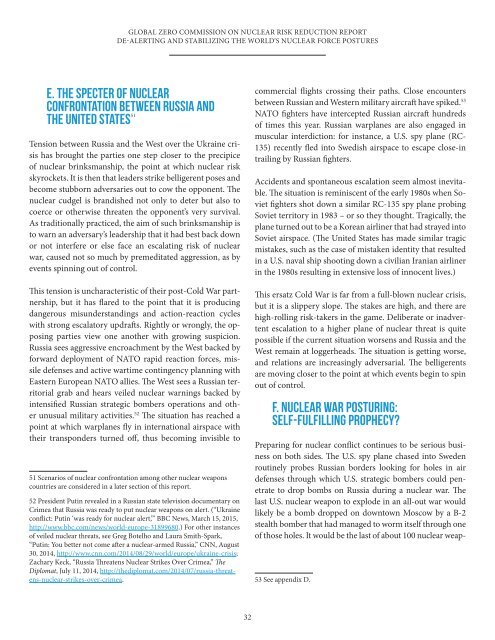global_zero_commission_on_nuclear_risk_reduction_report
global_zero_commission_on_nuclear_risk_reduction_report
global_zero_commission_on_nuclear_risk_reduction_report
Create successful ePaper yourself
Turn your PDF publications into a flip-book with our unique Google optimized e-Paper software.
GLOBAL ZERO COMMISSION ON NUCLEAR RISK REDUCTION REPORTDE-ALERTING AND STABILIZING THE WORLD’S NUCLEAR FORCE POSTURESE. THE SPECTER OF NUCLEARCONFRONTATION BETWEEN RUSSIA ANDTHE UNITED STATES 51Tensi<strong>on</strong> between Russia and the West over the Ukraine crisishas brought the parties <strong>on</strong>e step closer to the precipiceof <strong>nuclear</strong> brinksmanship, the point at which <strong>nuclear</strong> <strong>risk</strong>skyrockets. It is then that leaders strike belligerent poses andbecome stubborn adversaries out to cow the opp<strong>on</strong>ent. The<strong>nuclear</strong> cudgel is brandished not <strong>on</strong>ly to deter but also tocoerce or otherwise threaten the opp<strong>on</strong>ent’s very survival.As traditi<strong>on</strong>ally practiced, the aim of such brinksmanship isto warn an adversary’s leadership that it had best back downor not interfere or else face an escalating <strong>risk</strong> of <strong>nuclear</strong>war, caused not so much by premeditated aggressi<strong>on</strong>, as byevents spinning out of c<strong>on</strong>trol.This tensi<strong>on</strong> is uncharacteristic of their post-Cold War partnership,but it has flared to the point that it is producingdangerous misunderstandings and acti<strong>on</strong>-reacti<strong>on</strong> cycleswith str<strong>on</strong>g escalatory updrafts. Rightly or wr<strong>on</strong>gly, the opposingparties view <strong>on</strong>e another with growing suspici<strong>on</strong>.Russia sees aggressive encroachment by the West backed byforward deployment of NATO rapid reacti<strong>on</strong> forces, missiledefenses and active wartime c<strong>on</strong>tingency planning withEastern European NATO allies. The West sees a Russian territorialgrab and hears veiled <strong>nuclear</strong> warnings backed byintensified Russian strategic bombers operati<strong>on</strong>s and otherunusual military activities. 52 The situati<strong>on</strong> has reached apoint at which warplanes fly in internati<strong>on</strong>al airspace withtheir transp<strong>on</strong>ders turned off, thus becoming invisible to51 Scenarios of <strong>nuclear</strong> c<strong>on</strong>fr<strong>on</strong>tati<strong>on</strong> am<strong>on</strong>g other <strong>nuclear</strong> weap<strong>on</strong>scountries are c<strong>on</strong>sidered in a later secti<strong>on</strong> of this <strong>report</strong>.52 President Putin revealed in a Russian state televisi<strong>on</strong> documentary <strong>on</strong>Crimea that Russia was ready to put <strong>nuclear</strong> weap<strong>on</strong>s <strong>on</strong> alert. (“Ukrainec<strong>on</strong>flict: Putin ‘was ready for <strong>nuclear</strong> alert,’” BBC News, March 15, 2015,http://www.bbc.com/news/world-europe-31899680.) For other instancesof veiled <strong>nuclear</strong> threats, see Greg Botelho and Laura Smith-Spark,“Putin: You better not come after a <strong>nuclear</strong>-armed Russia,” CNN, August30, 2014, http://www.cnn.com/2014/08/29/world/europe/ukraine-crisis;Zachary Keck, “Russia Threatens Nuclear Strikes Over Crimea,” TheDiplomat, July 11, 2014, http://thediplomat.com/2014/07/russia-threatens-<strong>nuclear</strong>-strikes-over-crimea.commercial flights crossing their paths. Close encountersbetween Russian and Western military aircraft have spiked. 53NATO fighters have intercepted Russian aircraft hundredsof times this year. Russian warplanes are also engaged inmuscular interdicti<strong>on</strong>: for instance, a U.S. spy plane (RC-135) recently fled into Swedish airspace to escape close-intrailing by Russian fighters.Accidents and sp<strong>on</strong>taneous escalati<strong>on</strong> seem almost inevitable.The situati<strong>on</strong> is reminiscent of the early 1980s when Sovietfighters shot down a similar RC-135 spy plane probingSoviet territory in 1983 – or so they thought. Tragically, theplane turned out to be a Korean airliner that had strayed intoSoviet airspace. (The United States has made similar tragicmistakes, such as the case of mistaken identity that resultedin a U.S. naval ship shooting down a civilian Iranian airlinerin the 1980s resulting in extensive loss of innocent lives.)This ersatz Cold War is far from a full-blown <strong>nuclear</strong> crisis,but it is a slippery slope. The stakes are high, and there arehigh-rolling <strong>risk</strong>-takers in the game. Deliberate or inadvertentescalati<strong>on</strong> to a higher plane of <strong>nuclear</strong> threat is quitepossible if the current situati<strong>on</strong> worsens and Russia and theWest remain at loggerheads. The situati<strong>on</strong> is getting worse,and relati<strong>on</strong>s are increasingly adversarial. The belligerentsare moving closer to the point at which events begin to spinout of c<strong>on</strong>trol.F. NUCLEAR WAR POSTURING:SELF-FULFILLING PROPHECY?Preparing for <strong>nuclear</strong> c<strong>on</strong>flict c<strong>on</strong>tinues to be serious business<strong>on</strong> both sides. The U.S. spy plane chased into Swedenroutinely probes Russian borders looking for holes in airdefenses through which U.S. strategic bombers could penetrateto drop bombs <strong>on</strong> Russia during a <strong>nuclear</strong> war. Thelast U.S. <strong>nuclear</strong> weap<strong>on</strong> to explode in an all-out war wouldlikely be a bomb dropped <strong>on</strong> downtown Moscow by a B-2stealth bomber that had managed to worm itself through <strong>on</strong>eof those holes. It would be the last of about 100 <strong>nuclear</strong> weap-53 See appendix D.32


